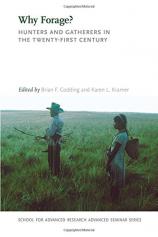Why Forage?: Hunters and Gatherers in the Twenty-First Century
Review
Why Forage?: Hunters and Gatherers in the Twenty-First Century
Foraging is as old as the human species. Twelve thousand years ago, we were all hunter-gatherers who subsisted by "collecting wild resources," according to Brian F. Codding and Karen L. Kramer, University of Utah professors of anthropology and editors of this latest look at the ever-changing aspects of this ancient survival strategy.
In various remote settings --- Canada, the Kalahari, Central Africa, Australia --- there are foraging peoples who are not, the editors stress, "relics of the past." On the contrary, they have been forced to continue adapting because of the increasing proximity of settled peoples. In fact, their environments have always been in transition. Still, when possible and as much as possible, these groups choose not to produce food. Codding and Kramer remind us that for these individuals, there are benefits to foraging, as well as drawbacks to not doing so.
"One purpose that this fact-filled resource may undoubtedly serve is to dispel certain misconceptions that we all have about foraging..."
The Pumé of Venezuela ("Diversify or Replace") move five to six times a year, use no currency, and if they do occasional work, they take their pay in the form of rice or pasta. They sometimes cultivate their staple food crop, manioc, but continue to forage for wild tubers. The Inuit or Eskimo peoples of Canada ("Inuit Culture") have gradually allowed themselves to accept government supports such as housing and wage labor, particularly since the collapse of the sealskin market that used to form one of their major trading resources. They still prefer to get their high energy food from hunting for seals and caribou, but now are forced to range farther to find them. This requires the use of snowmobiles; one Inuit man stated that he worked solely to pay for his snowmobile, used primarily for hunting. The government has provided a further adaptive response to the plight of the hunters by supporting them to act as guides for sport-hunting tourists.
In Central Africa ("In Pursuit of the Individual"), the incursion of the cash economy in the form mainly of rubber plantations in the last century forced small farmers out to marginal lands that they must share with foragers. The farmers consider the foragers to be "primitive," and the two groups persist in maintaining very different cultural norms, but trade and social occasions (weddings, funerals, circumcision rituals) may bring them together more often than before. Among the aboriginal people of Australia ("Alternative Aboriginal Economies"), foraging allows for the continuation of a network of social sharing, one of the major benefits of the strategy, almost equal in importance to the food products gleaned or hunted. But, as in other places, foraging now requires traveling farther, necessitating the use of expensive vehicles, the funds for which come largely from welfare. Again this is an example of the dominant culture adapting to the foragers' lifestyle and the foragers altering their activities to adapt to the dominant culture.
With numerous graphs, charts and definitions in two appendices, WHY FORAGE? evolved from a seminar --- "Twenty-first Century Hunting and Gathering: Foraging on a Transnational Landscape" --- presented by the School for Advanced Research in New Mexico, in 2013. One purpose that this fact-filled resource may undoubtedly serve is to dispel certain misconceptions that we all have about foraging, such as that it is practiced by people living in “stone-age” cultures, a belief that doesn’t take into account the extreme adaptability of those hardy souls who continue to band together to hunt and gather their primary foods.
Reviewed by Barbara Bamberger Scott on December 2, 2016
Why Forage?: Hunters and Gatherers in the Twenty-First Century
- Publication Date: June 15, 2016
- Genres: Economics, Nonfiction
- Paperback: 352 pages
- Publisher: University of New Mexico Press
- ISBN-10: 0826356966
- ISBN-13: 9780826356963



